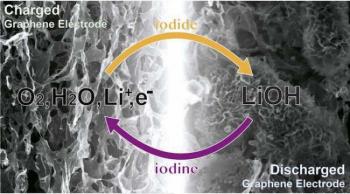Scientists at the University of Cambridge have created a graphene-based lithium-oxygen battery that is extremely energy dense, can be recharged more than 2000 times, and is 90% more efficient than current models. Lithium-oxygen batteries as regarded as the "ultimate" batteries because their theoretical energy density is ten times higher than a lithium-ion battery.

The researchers offered potential solutions to some of the problems facing such batteries before they can be realized, by producing a lab-based demonstrator of a lithium-oxygen battery that is a huge improvement over previous models. The new device relies on a highly porous carbon electrode made from graphene and other chemical additives. Although not all the problems have been solved, the results are a great advancement and show routes forward towards a practical device.
While this research indeed gives hope for the future, the development of a usable form of such a battery is likely still about a decade away. The team plans to find a way to protect the metal electrode and solve further safety issues.
Source: hngn